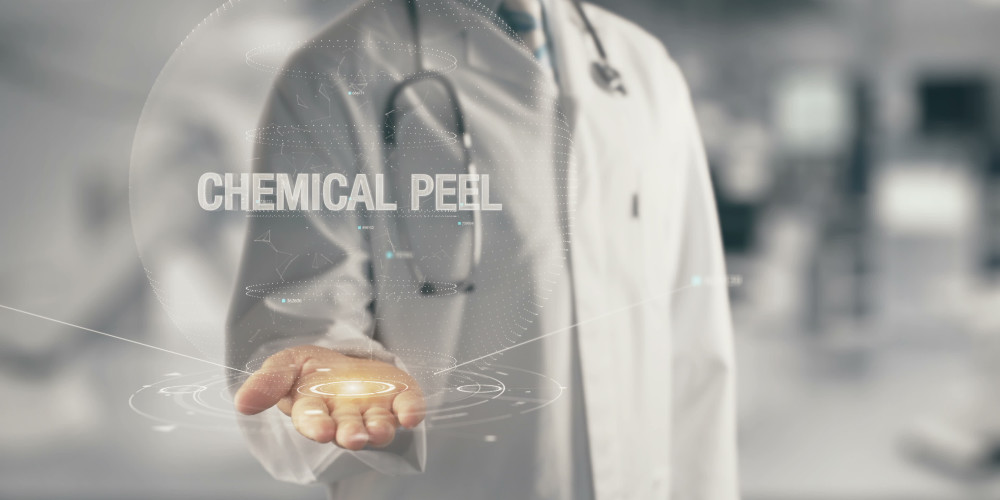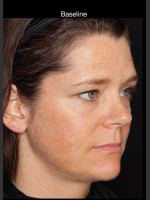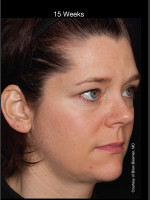What Exactly Is A Chemical Peel?

By Brent Martin, MD
The skin is a powerful organ that has the ability to protect your body from the outside environment all while having the ability to repair itself when damaged. Damage results from cumulative exposure to light or chemicals along with the wear and tear of everyday life. Unfortunately, our body's skin repair mechanisms do have their limits. If you find yourself looking in the mirror and kicking yourself for not having a better skincare regimen over the years, a trip to the dermatologist to discuss chemical peels may be a wise choice.
What is a Chemical Peel?
A chemical peel is a non-surgical dermatologic technique that applies an exfoliating chemical solution to the skin, causing it to peel and regenerate. The procedure is frequently used on the face, neck and hands and can be used to reduce the appearance of various skin complaints such as discoloration and hyperpigmentation, acne scars, blotchiness, melasma, sun damage and signs of aging such as crow’s feet, wrinkles and sagging.
Chemical peels are a popular choice not only because they can be performed as an outpatient procedure, but also offer immediate results. According to the American Society of Plastic Surgeons' yearly report, chemical peels made the list of the top five minimally invasive cosmetic procedures last year with 1.5 million done in 2018
Types of Chemical Peels
Your dermatologist will be able to help you determine which type of peel will be the most effective after understanding your goals and assessing your skin. Chemical peels address different areas in different ways. There are superficial peels (also known as light peels or lunchtime peels) that utilize mild acids composed of alpha hydroxy acids, such as glycolic, lactic, salicylic to exfoliate the outermost layer of skin. These peels are ideal for patients who do not want to spend much time recovering from a deeper peel. Light peels address fine wrinkling, mild discoloration, areas of dryness and acne and gives an overall refreshed look. With proper care, these types of peels take roughly one week to heal. Makeup can usually be worn the day after.
Medium strength peels usually contain trichloroacetic acid (TCA) or stronger variations of glycolic acid. The advantage to medium strength peels is that they treat fine surface wrinkles, pigmentation issues such as age spots and superficial blemishes better than superficial peels. Care should be taken in more darkly complected individuals as they might heal with areas of darkening related to inflammation. This peel penetrates the outer and middle layers of skin and therefore takes about 2 weeks to heal. Swelling and blistering are more common compared to the superficial peel.
The deepest peels are the strongest of the facial peels and reach deeper into the middle layer of the skin using stronger variations of trichloroacetic acid or phenol. They can help reduce the appearance of deeper lines and wrinkles, and even shallow scars and pre-cancerous growths in addition to age spots and freckles. This procedure produces the longest lasting results, but takes the longest time to complete in office (1-2 hours) and requires an extensive recovery routine for two to three weeks. Minimal sun exposure for three to six months is recommended along with copious sunscreen applications when present in the sun. It is important to note that phenol peels may cause permanent lightening of the skin and prospective patients should seek advice only from a dermatologist experienced in this technique before undergoing this procedure.
Chemical Peel Side Effects
After any chemical peel, individuals commonly experience redness, stinging, crusting and some peeling with stronger reactions corresponding with the depth of the peel. Rest assured, these chemical peel side effects usually subside within a week for superficial peels and 1-2 weeks for medium strength peels. For the deepest peels, side effects such as persistent redness and swelling typically last 2-3 weeks. Additional, but less common side effects can include scarring and reactivation of cold sores. For this reason, antiviral medication is typically prescribed for a course of 10-14 days after medium depth and deep peels. Follow-up appointments are required following medium strength and deep peels.
Given the nature of the procedure, chemical peels are not recommended for those with skin infections, active skin conditions such as psoriasis, eczema and rosacea, active cold sores, sunburns, those who are nursing or pregnant, or those currently taking or have taken Accutane within 6 months. It is recommended to stop using retinol products as well as acidic, bleaching or other skin-lightening products for at least 48 hours prior to a chemical peel. Those with a tendency to scar should avoid peels as well. Keep in mind that peels work best for light-skinned individuals.
At Home Chemical Peels
At-home chemical peels have become popular in recent years, but many chemical peels advertised for home use should not be used without supervision to avoid potential complications that were discussed above. While researching at-home peels, it is paramount to check the concentration of the active acid in the product; ideally less than 10 percent alpha hydroxy acid. The Food and Drug Administration recommends that a product with more than 30 percent acid should only be used in a professional medical environment.
In summary, while fillers can erase lines and wrinkles, chemical peels help rejuvenate the skin by removing old tissue and allowing for the regeneration of new skin. This leads the way for healthier looking skin, which is key to having a more youthful appearance. It is crucial to be informed about your own skin, the procedures you choose to have done, and who is doing them. With the right education and preparation, a chemical peel may well be a good choice to help you obtain younger and healthier looking skin.


